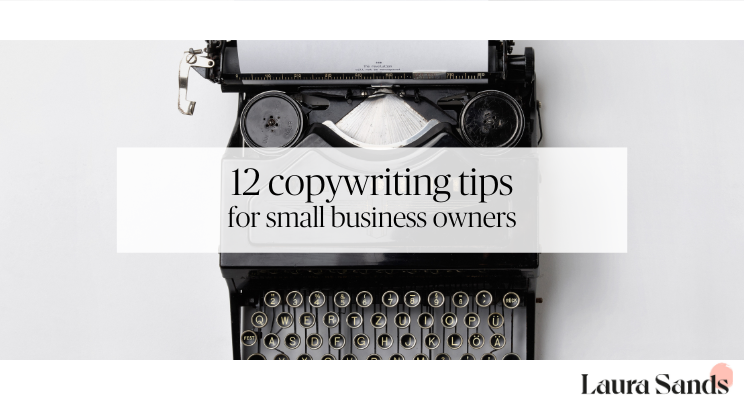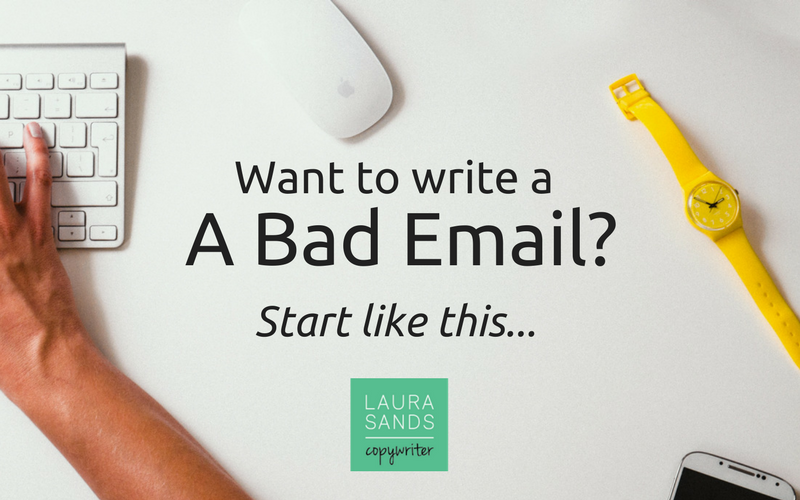
As a small business owner, you need to master a range of skills. As well as finance manager, CEO and pot washer, you need to be a copywriter. And the truth is that although copywriting seems simple at first, it can quickly become overwhelming. My copywriting tips for small business owners are just what you need!
Copywriting tips for small business owners.
Are you ready? Coffee in hand? Let’s go…
- Writing doesn’t need to be a drama. You’re just communicating with your audience. If you feel anxious as you approach your keyboard, then try some mind tricks to help you relax into it. One such trick is to pretend you’re talking to just one person – you’ll feel yourself slipping into a much more comfortable frame of mind, ready to write!
- Worries about your grammar? Install Grammarly – it’s what all the copywriters are using. It handily checks your grammar & gives you a little nudge if things look incorrect. Beware, the free version has a fondness for Oxford commas & American spellings, so use it with good judgement and align it with your preferences.
- Forget yourself. You’re not writing for yourself. You’re writing for your audience. So make sure your writing talks to them about what they’ll get. Not what you can deliver.
- Bad writing is better than no writing. After all, you can’t edit a blank page. So, no matter how uninspired you feel or how bad your cold, get something down on the page. Chances are it won’t look that bad when you review it. Speaking of which…
- Sleep on it. Leave everything you’ve written for a good few hours before you send/upload/share it. Overnight (or even longer if you have the time) is best. You’ll be amazed at how much you want to change on your final reading.
- If it’s not your idea, say so. After all, you’ll just get into hot water if you try to pass off an idea or passage as your own. And in any case, it’s an opportunity to link to or mention your contributor, by which you broaden your audience. Either link to your source in your writing, or mention your source by name. (A link to their website or social media profile is a nice touch here too.)
- Share! What’s the point of writing fine words if they just sit on your laptop or blog without seeing the light of day? Share, share and share again. And then repurpose it so you can share it even more. The world deserves to see your brilliance, wouldn’t you say?
- SEO is dead. Or so they keep saying. If you want your online writing to index well with search engines, you need to write naturally. Keep it relevant to your audience and use a broad range of vocabulary that refers to your “keywords” – not that anyone admits to using these anymore.
- Don’t rely on the robots. AI can be helpful, but please don’t rely on it to write your content. You’ll only end up with something mindnumbingly generic. That’s because AI sources its information from what’s already out there. If you write your content with AI, you’ll have something that’s essentially an internet word salad. Wondering what to do instead? Here’s a great place to start…
- Leave out unnecessary words. The more words you include, the more your audience needs to process, and the more likely they are to stop reading. Remove words such as “to”, “of”, “then” and “that”. This goes a long way to making your copy that little bit easier to read.
- Don’t fret about the beginning. It can be easier to get stuck into the meat of what you’re trying to say and then build your writing up around it. Don’t worry about finding the perfect opening paragraph – just leave it, write the rest of your document and then come back to it later on.
- Get help. No one is an island. If you’re really struggling, get a copywriter (shameless plug, my apologies!). Otherwise, ask willing (and capable) friends and family to proofread your work and give you feedback. A brainstorming session with your network can go a long way to giving you new ideas for your next few blog posts or emails.
Looking for more copywriting help?
As a copywriter who regularly writes for small and medium sized businesses, I can help you in a number of ways.
- I can write for you. Give me a call, tell me what you need and I’ll get writing!
- You can book a 121 inspiration call. You can use these calls in any way you like – from brainstorming ideas to coaching you to write perfect blogs.
- You could join one of my copywriting workshops. I run a range of free and paid workshops, they all contain copywriting tips for small business owners!
- You could sign up for my email. You’ll get a monthly update with advice and news to help you improve your writing. You’ll also get a free blogging basics guide to help you get started!
One of my lovely clients had a deadline. It was a deadline for me no less; she wanted to send me a draft page for me to work some magic on, in readiness for her new business launch.
Now, this lady is a talented photographer and knows all there is to know about her new business. She’s also been self-employed for a while and has launched websites before. It’s fair to say she knows what she’s doing.
But she had blank page syndrome. Writer’s block. Brain freeze. Don’t know what to do.
“I just don’t know where to start”, she told me. “Can you send me some pointers?”
So I whizzed her some thoughts back and then thought, that there must be hundreds, perhaps thousands of other folks out there with exactly the same problem as she has. So here’s a blog to help!
How to get started when you don’t know where to begin.
I can empathise. I know this pain completely. Which I why I thought I would give you my run-down of ways to lose blank page syndrome.
 Shut down your computer. Honestly, staring at a blank screen is the worst way to get started. So go old school. The bigger the piece of paper the better. If A4 is all you have, then go with that – I like to use A3. Don’t even think of using a post-it note.
Shut down your computer. Honestly, staring at a blank screen is the worst way to get started. So go old school. The bigger the piece of paper the better. If A4 is all you have, then go with that – I like to use A3. Don’t even think of using a post-it note.
Now just start writing words. You could make a mind map, write lists, draw pictures. Anything. After a while you’ll start getting a feel for the shape of things you want to write. Trust me.
Pretend. Sometimes, one of the best ways to banish writer’s block is to pretend you are writing a letter or explaining something to someone who doesn’t understand what you do. Perhaps the old boy you met in a café. Or your maiden great aunt (if you don’t have one, imagine for a moment that you do). By writing as if you are explaining things (which in effect, you are), you will naturally write more clearly and simply. Which is exactly what you should be aiming for. It also means you pre-empt the questions your audience would naturally ask. Bingo!
Forget the beginning. We get so hung up on the way we start things. So, begin with the part you find easiest to write and then just shape everything around it. Or even better, get someone like me to help you whip it into shape for you.
Go rough. Bad writing is always, always, always better than no writing at all. You can’t edit a blank page after all. So just start typing away. You’ll probably hate what you’re writing, but that’s fine. Because after you’ve spent some time editing it, it will be just what you want.
A bit at a time. If you’re writing a webpage or blog, don’t pressure yourself into completing it in one sitting. That won’t work. Give yourself a series of 30-minute sessions to break the back of it and form a shape. That way you’ll stay fresh and give yourself time to reflect.
If it makes you feel better, then know that I have never, ever, ever written and edited a blog or webpage in one sitting.
Still struggling with writer’s block?
If you’re really struggling, then ask yourself:
- Who this copy is aimed at?
- What do I want my audience to do as a result of reading this?
- What are the key messages I want to communicate?
- Do I want to include keywords (and what are they)?
See, sometimes, we struggle because we’ve just not planned properly. I mean, imagine trying to go somewhere new without a map, satnav or roadsigns. You couldn’t. It’s the same with writing. Make a plan and use it.
With these questions answered, you can go back and then make a start.
Do you need professional help with your writing?
If, after all that, you’re still struggling, perhaps you need professional help. Give me a shout and we can chat through the ways in which I can help you. From a consultation call, to writing on your behalf, there are many ways I can help.
Get in touch and we can set up a call.
* The header image for this blog is by Kelly Sikkema on Unsplash.
Too much waffle? Here’s how to write clearly and conciselyThere’s no magic in learning how to write clearly and concisely. But there are a few tricks involved.
There’s a real benefit to being able to write clearly and concisely – it can supercharge your other skills. If you’re able to get your point across and make it easily understood, you will appear more confident, authoritative, and even more persuasive.
Interested? Here’s where you begin…
How to make your writing more refined
Coco Chanel famously said, “before you leave the house, look in the mirror and remove one accessory”. It’s an analogy that’s perfect for decongesting stodgy copy.
That’s because the best thing to do before you hit publish or send to print is to take a good hard look at your writing and remove the things that aren’t necessary. This will make your writing flow and read more smoothly – ultimately, you need to take things away to get clear, concise copy.
And let’s be honest – we’ve all been there. Writing emails, presentations or webpages in a rush, against a deadline. You tap away, creating a stream of consciousness. You give it a quick proof to make sure it reads OK – you check that you got your apostrophes in the right place and make sure you haven’t got any typos. And then you save it and move on to the next thing.
Then one day you come back to it. Or worse still, someone else reads it. And you realise that your writing is horrifically rambling. Some of the sentences don’t make sense. The call to action isn’t clear; no wonder you didn’t get the result you needed.
Three easy ways to write concisely and clearly
If you know your writing is wordy how can you fix it?
Here are three easy things you can do:
- Cut out the waffle. Step away from the long phrases. Never use five words where one will do. Replace phrases such as “in order to”, with plain old simple “to”. Instead of “by way of introduction”, write “introducing”. Adding too many words won’t appear polite or refined. It will complicate and distract from your main message.
- Lose the big words. Unless you’re writing a QI appreciation blog, it’s unlikely you’ll need super-duper long words. Use simple English. Long words don’t make you look clever, but they do suggest you don’t care whether or not people understand you. And worse still, long words are easily misspelt which makes you look daft. Stay in touch with your reader and don’t give anyone a chance to doubt you – use simple, direct language.
- Basic punctuation. Use your full stop. Long sentences are prime fodder in creating wordy text. They go on and on, using a record number of commas and confusing everyone. Keep your sentences under control and stick to one or two ideas only. If you find yourself bringing in lots of commas, “ands”, and “buts” etc. it’s a good idea to take control and get out your full stops. Chop down those sentences – let your reader take a breather.
Another thing to help you write clearly and concisely
Here’s a bonus tip for you… download the Grammarly app to your computer. The free app is just fine (it’s what I use) and will call out any rambling sentences for you to examine. It can be a bit pernickety, so don’t feel you have to do everything it tells you. However, it’s a useful tool for anyone who writes.
If you found this post useful, you might get something from one of my other blog posts. How about my guide to using alt-texts? (It tells you how to make the images on your website SEO friendly and more accessible).
(The frankly mouthwatering photo at the top of my blog is courtesy of Cristina Matos-Albers on Unsplash.)
Want to write a bad email? Start like this… It slips off your tongue easily and finds its way off your fingers and onto a keyboard even more easily. But kicking off with an apology is one of the fastest ways I know of starting an email on the wrong foot.
It slips off your tongue easily and finds its way off your fingers and onto a keyboard even more easily. But kicking off with an apology is one of the fastest ways I know of starting an email on the wrong foot.
Sorry. Forgive me. My apologies. Whoops-a-daisy. My bad.
You get the picture.
Why you shouldn’t start with sorry
The person reading your email will be ready to wonder what you’ve done. Should they feel aggrieved? Impatient? Irritated? You’re certainly suggesting they have a right to be. As we humans are highly suggestible there’s a chance that even if they weren’t aware of the wrong you’d committed, and couldn’t have given two hoots, they may be a bit less than impressed with you than they were 10 minutes previously.
An example…
Let’s say you’ve sent something a bit later than promised. Train delays, kids off school, cat to the vets with a mystery cough… life happens. You finally whizz off the email to your contact, starting with an almost out of breath “sorry this is so late…”.
What’s the first thing the recipient thinks? “urgh… late again”. They sigh as they sip their coffee and add a little black mark against your name in their imaginary list of “people I deal with”.
If you were just an hour or so late, you’d have been better not mentioning it at all. There’s a chance they hadn’t even realised your note was late. If you were over a clear deadline or a day or so late, you could replace an effusive apology with a more assured “thank you for your patience…” – a trick you might have seen elsewhere.
Thank you for your patience
It’s something doctors say, you’ve probably heard it before…
You’ve been waiting in a stuffy waiting room with only copies of the “People’s Friend” for entertainment. It’s been 45 minutes and you’re ready to create merry hell. The doctor eventually calls you in and says “thank you for your patience”. They may even explain why they’re so over their schedule. Because your doctor is lovely and you know they do a good job, you readily forgive. After all, you don’t mind being patient do you?
Instead of apologising for a small and understandable deficiency on their part, the doctor praises you for a positive behaviour. It’s a small thing, but it makes a big difference to the way you feel. “Thank you for your understanding” works just as well. You make people feel good about their behaviour, shifting the emphasis off yourself. But sometimes this isn’t appropriate; perhaps a big fat “sorry” is in order.
When the situation demands an apology.
You don’t need me to tell you this. In situations that require an apology, you should say sorry.
But you don’t need to start your email with an apology. Get into the solution, help resolve the situation. Something along the lines of “I see what has happened. I’ll get back to you with XYZ by lunchtime tomorrow”. Then add your apology.
In fairness, if you’ve made a mistake that demands an apology you probably need to get on the phone and talk it through. But because you’ll be following up that phone call with an email as well, you need to remember to think carefully about how and where you place that necessary apology.
Sorry? What was that?
Say sorry. Show sorry. But start an email with a “sorry”? There’s never any need to do that.
Do you agree? Or not? Let me know.
